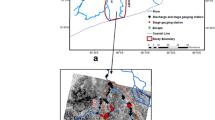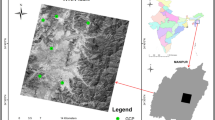Abstract
An accurate flood mapping is a non-structural measure that helps to reduce damages and minimizes losses. The availability of large-scale and good quality topographic input data is of great concern for such studies. The present study involves the integration of Cartosat-1 stereo image pairs (remotely sensed) and ground truth points (surveyed) to develop digital elevation model (DEM) for the Mahanadi delta in India. The integration was performed for two cases: (i) A single Cartosat-1 image at a time and (ii) Aggregation of Cartosat-1 images one after another. Both the cases involve different numbers of ground control points (GCPs) (to be integrated with Cartosat-1 images) to study the quality and suitability of DEMs for flood inundation modeling. The best one among the DEMs prepared for each Cartosat-1 image with different number of GCPs was further used for hydrodynamic modeling. The MIKE 11 model was calibrated for 2009 and validated for 2010 using cross-sections extracted from Cartosat-1 DEMs. Further, bathymetry for the MIKE 21 model was prepared using the best Cartosat-1 DEM. MIKE FLOOD model setup was prepared to simulate flood inundation for the year 2011. The results indicate that DEMs of reasonable quality can be generated by incorporating GCPs and rational polynomial coefficients. The areal extent of simulated flood using MIKE FLOOD is in reasonable agreement with the observed counterpart.













Similar content being viewed by others
References
Adikari, Y., Osti, R., & Noro, T. (2010). Flood-related disaster vulnerability: An impending crisis of megacities in Asia. Journal of Flood Risk Management, 3, 185–191. https://doi.org/10.1111/j.1753-318X.2010.01068.x
Afshari, S., Tavakoly, A. A., Rajib, M. A., Zheng, X., Follum, M. L., Omranian, E., & Fekete, B. M. (2018). Comparison of new generation low-complexity flood inundation mapping tools with a hydrodynamic model. Journal of Hydrology, 556, 539–556. https://doi.org/10.1016/j.jhydrol.2017.11.036
Azizian, A., & Brocca, L. (2020). Determining the best remotely sensed DEM for flood inundation mapping in data sparse regions. International Journal of Remote Sensing, 41(5), 1884–1906. https://doi.org/10.1080/01431161.2019.1677968
Bates, P. D., & De Roo, A. P. J. (2000). A simple raster-based model for flood inundation simulation. Journal of Hydrology, 236(1), 54–77. https://doi.org/10.1016/S0022-1694(00)00278-X
Bellos, V., & Tsakiris, G. (2015). Comparing various methods of building representation for 2D flood modelling in built-up areas. Water Resources Management International Journal Published for the European Water Resources Association (EWRA), 29(2), 379–397.
Bhang, K. J., Schwartz, F. W., & Braun, A. (2007). Verification of the vertical error in C-band SRTM DEM using ICESat and Landsat-7, Otter Tail County, MN. IEEE Transactions on Geoscience and Remote Sensing, 45(1), 36–44. https://doi.org/10.1109/TGRS.2006.885401
Bildirici, O. I., Ustun, A., Selvi, Z. H., Abbak, A. R., & Bugdayci, I. (2009). Assessment of shuttle radar topography mission elevation data based on topographic maps in Turkey. Cartography and Geographic Information Science, 36(1), 95–104. https://doi.org/10.1559/152304009787340205
Bourdin, D. R., Fleming, S. W., & Stull, R. B. (2012). Streamflow modelling: A primer on applications approaches and challenges. Atmosphere-Ocean, 50(4), 507–536. https://doi.org/10.1080/07055900.2012.734276
Brunner, G. W. (2016). HEC-RAS river analysis system-user's manual version 5.0. US army corps of engineers. Institute for water resources, hydrologic engineering center (HEC), p. 962.
Burrel, B. C., Davar, K., & Hughes, R. (2007). A review of flood management considering the impacts of climate change. Water International, 32(3), 342–359. https://doi.org/10.1080/02508060708692215
Chatterjee, C., Förster, S., & Bronstert, A. (2008). Comparison of hydrodynamic models of different complexities to model floods with emergency storage areas. Hydrological Processes, 22(24), 4695–4709. https://doi.org/10.1002/hyp.7079
CWC (2014). Central water commission, ministry of water resources, New Delhi.
DHI (2004). MIKE 11: A modeling system for rivers and channels–reference manual. Danish hydraulic institute: Horsholm, Denmark.
DHI (2014). MIKE 21–2D modelling of coast and sea. DHI water & environment Pty Ltd.
Giribabu, D., Kumar, P., Mathew, J., Sharma, K. P., & Murthy, Y. V. N. K. (2013). DEM generation using Cartosat-1 stereo data: Issues and complexities in Himalayan terrain. European Journal of Remote Sensing, 46(1), 431–443. https://doi.org/10.5721/EuJRS20134625
Hrachowitz, M., Savenije, H. H. G., Blöschl, G., McDonnell, J. J., Sivapalan, M., Pomeroy, J. W., Arheimer, B., Blume, T., Clark, M. P., & Ehret, U. (2013). A decade of predictions in ungauged basins (PUB)—a review. Hydrological Sciences Journal, 58(6), 1198–1255. https://doi.org/10.1080/02626667.2013.803183
Jacob, X. K., Bisht, D. S., Chatterjee, C., & Raghuwanshi, N. S. (2020). Hydrodynamic modeling for flood hazard assessment in a data scarce region: A case study of Bharathapuzha river basin. Environmental Modeling & Assessment, 25(1), 97–114. https://doi.org/10.1007/s10666-019-09664-y
Javaheri, A., & Babbar-Sebens, M. (2014). On comparison of peak flow reductions, flood inundation maps, and velocity maps in evaluating effects of restored wetlands on channel flooding. Ecological Engineering, 73, 132–145. https://doi.org/10.1016/j.ecoleng.2014.09.021
Jena, P. P., Panigrahi, B., & Chatterjee, C. (2016). Assessment of Cartosat-1 DEM for modeling floods in data scarce regions. Water Resources Management. https://doi.org/10.1007/s11269-016-1226-9
Khan, S. I., Hong, Y., Wang, J., Yilmaz, K. K., Gourley, J. J., Adler, R. F., Brakenridge, G. R., Policelli, F., Habib, S., & Irwin, D. (2011). Satellite remote sensing and hydrologic modeling for flood inundation mapping in lake Victoria basin: Implications for hydrologic prediction in ungauged basins. IEEE Transactions on Geoscience and Remote Sensing, 49(1), 85–95. https://doi.org/10.1109/TGRS.2010.2057513
Lomulder, R. (2004). Appropriate modelling: Application of Sosbek 1D2D for dike break and overtopping at the Elbe. Universiteit Twente.
Mani, P., Chatterjee, C., & Kumar, R. (2014). Flood hazard assessment with multiparameter approach derived from coupled 1D and 2D hydrodynamic flow model. Natural Hazards, 70(2), 1553–1574. https://doi.org/10.1007/s11069-013-0891-8
Mason, D. C., Trigg, M., Garcia-Pintado, J., Cloke, H. L., Neal, J. C., & Bates, P. D. (2016). Improving the TanDEM-X digital elevation model for flood modelling using flood extents from synthetic aperture radar images. Remote Sensing of Environment, 173, 15–28. https://doi.org/10.1016/j.rse.2015.11.018
Merwade, V. (2009). Effect of spatial trends on interpolation of river bathymetry. Journal of Hydrology. https://doi.org/10.1016/j.jhydrol.2009.03.026
Mukherjee, S., Joshi, P. K., Mukherjee, S., Ghosh, A., Garg, R. D., & Mukhopadhyay, A. (2013). Evaluation of vertical accuracy of open source digital elevation model (DEM). International Journal of Applied Earth Observation and Geoinformation, 21, 205–217. https://doi.org/10.1016/j.jag.2012.09.004
Muralikrishnan, S., Pillai, A., Narender, B., Reddy, S., Venkataraman, V. R., & Dadhwal, V. K. (2013). Validation of Indian national DEM from Cartosat-1 data. Journal of the Indian Society of Remote Sensing, 41(1), 1–13. https://doi.org/10.1007/s12524-012-0212-9
Nasir, S., Iqbal, I. A., Ali, Z., & Shahzad, A. (2015). Accuracy assessment of digital elevation model generated from pleiades tri stereo-pair. In: 2015 7th international conference on recent advances in space technologies (RAST), (pp. 193–197). https://doi.org/10.1109/RAST.2015.7208340.
National remote sensing centre (NRSC) (2014), Hyderabad, ISRO, department of space, government of India.
NDMA (2008). National disaster management guidelines: Management of floods. National disaster management authority, government of India, New Delhi.
Ntajal, J., Lamptey, B. L., Mahamadou, I. B., & Nyarko, B. K. (2017). Flood disaster risk mapping in the Lower Mono river basin in Togo, West Africa. International Journal of Disaster Risk Reduction, 23, 93–103. https://doi.org/10.1016/j.ijdrr.2017.03.015
Patra, J. P., Kumar, R., & Mani, P. (2016). Combined fluvial and pluvial flood inundation modelling for a project site. Procedia Technology, 24, 93–100. https://doi.org/10.1016/j.protcy.2016.05.014
Patro, S., Chatterjee, C., Mohanty, S., Singh, R., & Raghuwanshi, N. S. (2009). Flood inundation modeling using MIKE FLOOD and remote sensing data. Journal of the Indian Society of Remote Sensing, 37(1), 107–118. https://doi.org/10.1007/s12524-009-0002-1
Planning commission of India (2013). Twelfth five year plan (2012–2017). Faster, more inclusive and sustainable growth. vol. I., government of India, New Delhi.
Saksena, S., & Merwade, V. (2015). Incorporating the effect of DEM resolution and accuracy for improved flood inundation mapping. Journal of Hydrology, 530, 180–194. https://doi.org/10.1016/j.jhydrol.2015.09.069
Samantaray, D., Chatterjee, C., Singh, R., Gupta, P. K., & Panigrahy, S. (2015). Flood risk modeling for optimal rice planning for delta region of Mahanadi river basin in India. Natural Hazards, 76(1), 347–372. https://doi.org/10.1007/s11069-014-1493-9
Savage, J. T. S., Bates, P., Freer, J., Neal, J., & Aronica, G. (2016). When does spatial resolution become spurious in probabilistic flood inundation predictions. Hydrological Processes, 30(13), 2014–2032.
Sharma, A., & Tiwari, K. N. (2014). A comparative appraisal of hydrological behavior of SRTM DEM at catchment level. Journal of Hydrology, 519, 1394–1404. https://doi.org/10.1016/j.jhydrol.2014.08.062
Singh, S. K., Naidu, S. D., Srinivasan, T. P., Krishna, B. G., & S, P. K. (2008). Rational polynomial modelling for cartosat-1 data. The International Archives of the Photogrammetry, Remote Sensing and Spatial Information Sciences, 37, 885–888.
Tan, M. L., Ficklin, D. L., Dixon, B., Ibrahim, A. L., Yusop, Z., & Chaplot, V. (2015). Impacts of DEM resolution, source, and resampling technique on SWAT-simulated streamflow. Applied Geography, 63, 357–368. https://doi.org/10.1016/j.apgeog.2015.07.014
Tarekegn, T. H., Haile, A. T., Rientjes, T., Reggiani, P., & Alkema, D. (2010). Assessment of an ASTER-generated DEM for 2D hydrodynamic flood modeling. International Journal of Applied Earth Observation and Geoinformation, 12(6), 457–465. https://doi.org/10.1016/j.jag.2010.05.007
Teng, J., Jakeman, A. J., Vaze, J., Croke, B. F. W., Dutta, D., & Kim, S. (2017). Flood inundation modelling: A review of methods, recent advances and uncertainty analysis. Environmental Modelling & Software, 90, 201–216. https://doi.org/10.1016/j.envsoft.2017.01.006
Toda, L. L., Yokingco, J. C. E., Paringit, E. C., & Lasco, R. D. (2017). A LiDAR-based flood modelling approach for mapping rice cultivation areas in Apalit, Pampanga. Applied Geography, 80, 34–47. https://doi.org/10.1016/j.apgeog.2016.12.020
Tsanis, I. K., Seiradakis, K. D., Daliakopoulos, I. N., Grillakis, M. G., & Koutroulis, A. G. (2013). Assessment of GeoEye-1 stereo-pair-generated DEM in flood mapping of an ungauged basin. Journal of Hydroinformatics, 16(1), 1–18. https://doi.org/10.2166/hydro.2013.197
Varga, M., & Bašić, T. (2015). Accuracy validation and comparison of global digital elevation models over Croatia. International Journal of Remote Sensing, 36(1), 170–189. https://doi.org/10.1080/01431161.2014.994720
Vashist, K., & Singh, K. K. (2021). Minimisation of overestimation of river flows in 1D-hydrodynamic modeling. https://doi.org/10.21203/rs.3.rs-654833/v1
Villanueva, I., & Wright, N. G. (2006). Linking Riemann and storage cell models for flood prediction. Proceedings of the Institution of Civil Engineers Water Management, 159(1), 27–33. https://doi.org/10.1680/wama.2006.159.1.27
Wang, Y., & Zheng, T. (2005). Comparison of light detection and ranging and national elevation dataset digital elevation model on floodplains of North Carolina. Natural Hazards Review, 6(1), 34–40. https://doi.org/10.1061/(ASCE)1527-6988(2005)6:1(34)
Wilson, M., Bates, P., Alsdorf, D., Forsberg, B., Horritt, M., Melack, J., Frappart, F., & Famiglietti, J. (2007). Modeling large-scale inundation of Amazonian seasonally flooded wetlands. Geophysical Research Letters, 34(15), L15404. https://doi.org/10.1029/2007GL030156
Acknowledgements
The authors are grateful to the Odisha State Water Resources Department (SWRD), Cuttack, State Surface Water Data Centre (SSWDC), Bhubaneswar, and Central Water Commission (CWC), Bhubaneswar, for providing the necessary data to carry out the study.
Funding
The authors did not receive support from any organization for the submitted work.
Author information
Authors and Affiliations
Contributions
Abhishek Patel, Prachi Pratyasha Jena, Amina Khatun, Chandranath Chatterjee involved in conceptualization; Abhishek Patel, Prachi Pratyasha Jena, Amina Khatun, Chandranath Chatterjee involved in methodology; Abhishek Patel involved in formal analysis and investigation; Abhishek Patel, Amina Khatun involved in writing—original draft preparation; Abhishek Patel, Prachi Pratyasha Jena, Amina Khatun, Chandranath Chatterjee involved in writing—review and editing; Chandranath Chatterjee; Supervision: Chandranath Chatterjee involved in resources.
Corresponding author
Ethics declarations
Conflict of interest
The authors have no relevant financial or non-financial interests to disclose.
Additional information
Publisher's Note
Springer Nature remains neutral with regard to jurisdictional claims in published maps and institutional affiliations.
About this article
Cite this article
Patel, A., Jena, P.P., Khatun, A. et al. Improved Cartosat-1 Based DEM for Flood Inundation Modeling in the Delta Region of Mahanadi River Basin, India. J Indian Soc Remote Sens 50, 1227–1241 (2022). https://doi.org/10.1007/s12524-022-01525-8
Received:
Accepted:
Published:
Issue Date:
DOI: https://doi.org/10.1007/s12524-022-01525-8




